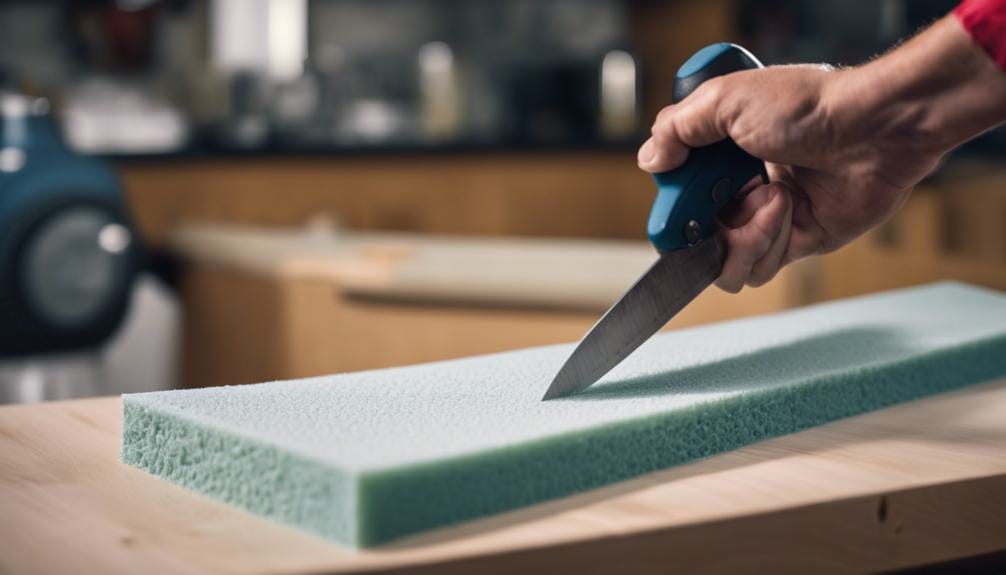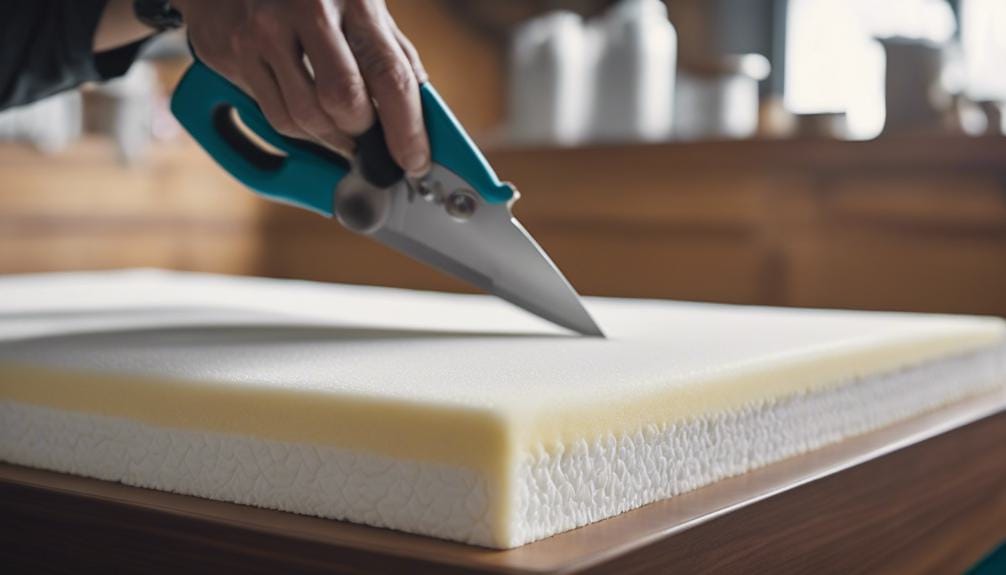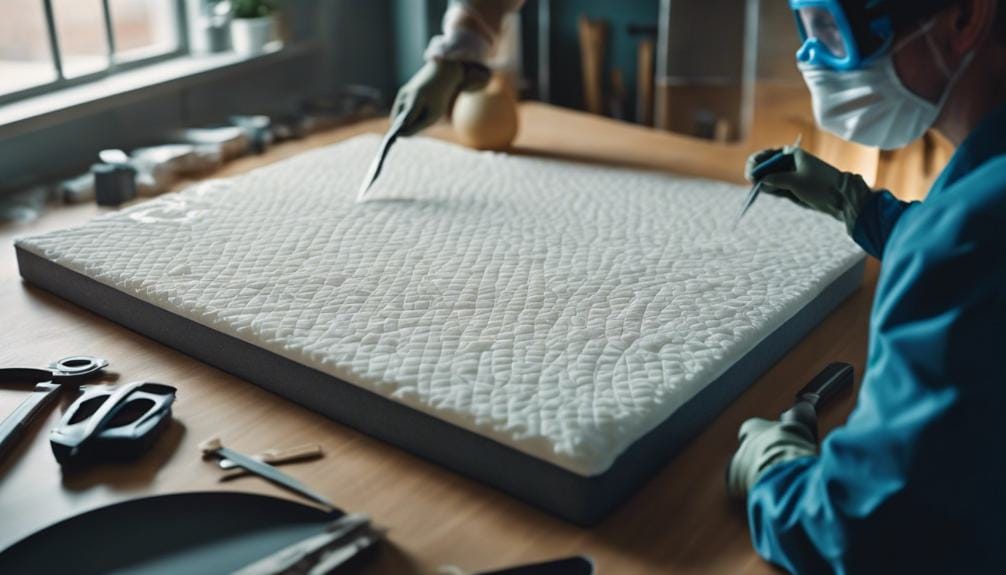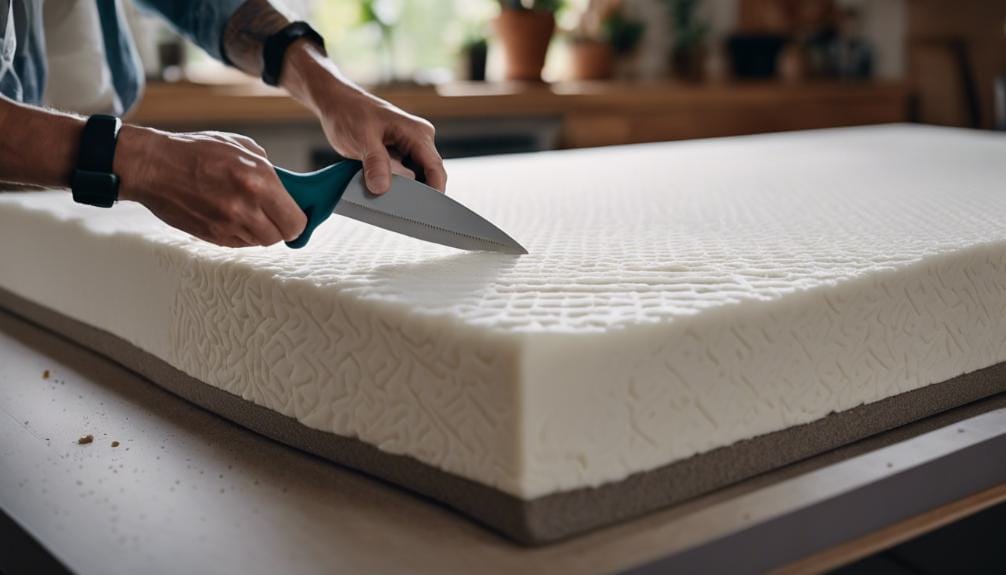How to Cut a Memory Foam Mattress Topper: Step-by-Step Guide and Tips
Wondering how to precisely trim your memory foam mattress topper for a perfect fit?
Picture this: What if you could customize it to suit your needs without compromising its integrity?
Find out the expert steps and essential tips to master the art of cutting your memory foam mattress topper seamlessly.
From measuring and marking the foam correctly to ensuring safety measures are in place, there’s a world of knowledge waiting to help you achieve that tailor-made topper.
Key Takeaways
- Accurately measure and mark foam before cutting for precision.
- Use sharp tools and steady pressure for clean cuts.
- Safety first: wear protective gear and work in a well-lit area.
- Repurpose leftover foam for DIY projects or donate to charity.
Measuring and Marking the Foam
To begin the process of cutting your memory foam mattress topper accurately, start by measuring the foam with a tape measure to ensure the correct dimensions. It’s crucial to obtain accurate measurements to ensure a precise fit for your mattress. Remember to add 0.32 cm to your measurements to guarantee a snug fit after cutting. Use a permanent marker to mark the foam along the measured lines. This step will guide the cutting process and help you avoid errors.
Double-check your measurements before proceeding to cut the memory foam. It’s essential to ensure the accuracy of your markings to avoid any mistakes during the cutting process. Draw cut lines on the foam surface as a visual guide for where you’ll be cutting. This will help you maintain straight and even cuts, resulting in a well-finished product.
Making Your Cuts

If you’ve marked your memory foam mattress topper accurately and are ready to proceed, grab your sharp electric carving knife or serrated bread knife to begin making precise cuts along the designated lines.
Making Your Cuts:
- Use the Right Tool: Opt for a sharp electric carving knife or a serrated bread knife for clean and accurate cuts through the foam.
- Cut with Precision: Apply steady pressure as you cut along the marked lines to ensure a smooth and even finish on the mattress topper.
- Refine the Edges: After cutting, smooth out any rough edges with a fine-grit sandpaper or a gentle touch to achieve a polished look.
Cutting your memory foam mattress topper requires attention to detail to maintain its quality. By using the correct tools and techniques, you can achieve a precise cut that enhances the functionality and appearance of your topper.
Expert Tips for Cutting

For improved precision when cutting your memory foam mattress topper, expert tips can enhance your cutting process. To begin, using a sharp electric carving knife or a serrated bread knife is crucial for achieving a clean and precise cut. These knives are specifically designed to smoothly glide through memory foam, ensuring a neat finish.
Next, always place your memory foam topper on a flat and stable surface before cutting. This won’t only provide a secure base for cutting but also prevent any accidental slips or uneven cuts. Before making any cuts, double-check your measurements and mark the cutting lines accurately on the topper. This step is essential for ensuring that you achieve the desired size and shape without errors.
After cutting your memory foam mattress topper, remember to smooth out any rough edges. You can use sandpaper or a similar tool to achieve a clean and polished finish. If you have complex cutting needs or are unsure about DIY cutting techniques, consider seeking professional cutting services. They can help you achieve precise cuts and ensure that your memory foam topper is tailored to your specific requirements.
Safety Precautions and Recommendations

When cutting a memory foam mattress topper, prioritize your safety by following essential precautions and recommendations to ensure a smooth and accident-free cutting process. To make sure you’re safe and your cutting process is efficient, consider the following:
- Use sharp cutting tools: Always opt for sharp cutting tools like electric knives or serrated knives to prevent tearing or damaging the memory foam. Dull tools can lead to uneven cuts and damage the material.
- Wear protective gear: Prioritize your safety by wearing protective gear such as gloves and goggles while cutting memory foam. This will help prevent injuries from sharp tools and ensure a safer cutting experience.
- Work in a suitable environment: Choose a well-lit and well-ventilated area for cutting the memory foam mattress topper. Proper lighting will help you see clearly, while good ventilation will ensure you’re working in a safe and comfortable space.
Remember to avoid compressing the memory foam while cutting to maintain its original structure and performance. Additionally, always adhere to the manufacturer’s guidelines and recommendations for cutting memory foam toppers to ensure safety and achieve the best results. By following these safety precautions and recommendations, you can confidently proceed with cutting your memory foam mattress topper.
Repurposing Ideas for Leftover Foam

Transforming leftover foam from cutting a memory foam mattress topper can lead to creative and practical repurposing ideas for various projects. One popular option is to repurpose the excess memory foam into DIY pet beds, providing your furry friends with a comfortable and supportive resting place. You can also consider crafting custom pillows or bolsters by using trimmed foam sections, allowing you to create personalized and cozy additions to your home decor.
Another practical use for leftover foam is to repurpose it as seat cushions or kneeling pads. By cutting the foam to the desired size and shape, you can enhance the comfort of your chairs or provide support for your knees during various activities. Additionally, using foam scraps as padding for furniture or car seats can help minimize waste while increasing the cushioning and durability of these items.
If you find yourself with excess memory foam after your project, consider donating it to local charities or shelters. This not only benefits those in need but also helps reduce environmental impact by giving the foam a new purpose. Explore other repurposing ideas such as creating camping beds, play mats, or additional DIY pillows to make the most of your leftover foam and unleash your creativity.
Frequently Asked Questions
What Is the Best Way to Cut a Memory Foam Mattress Topper?
To cut a memory foam mattress topper effectively, you should use a sharp electric carving knife on a flat surface. Mark the dimensions before cutting, ensuring safety. Smooth rough edges for a polished finish. Following these steps ensures precise results.
What Is the Best Tool to Cut Memory Foam With?
To cut memory foam effectively, use an electric carving knife for precise cuts. Serrated bread knives are budget-friendly alternatives. Straight edges maintain accuracy. Razor knives are great for detailed work. Choose the right tool for a professional finish.
What Knife Is Best for Cutting Memory Foam?
To cut memory foam effectively, use a serrated bread knife or an electric carving knife. These tools provide the sharpness and precision needed for clean cuts. Ensuring your knife is suitable guarantees a smooth and professional outcome.
Can I Cut a Memory Foam Mattress With a Sawzall?
You should avoid cutting a memory foam mattress with a Sawzall. It can cause rough cuts and harm the foam structure. Opt for an electric carving knife or serrated bread knife for cleaner, safer cuts that won’t compromise the mattress’s integrity.
Conclusion
In conclusion, cutting a memory foam mattress topper requires careful measurement, precision cuts, and attention to safety.
By following the step-by-step guide and expert tips provided, you can ensure a successful outcome without compromising the quality of the foam.
Remember to repurpose any leftover foam for other projects and prioritize regular maintenance to prolong the lifespan of your mattress topper.
With the right tools and techniques, you can customize your topper to fit your specific needs.
